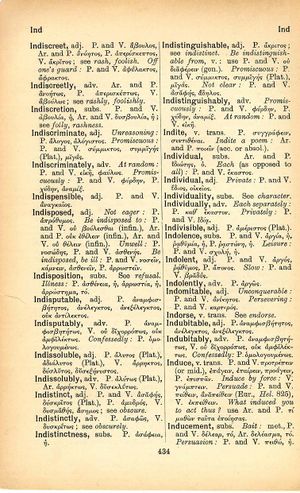induce: Difference between revisions
From LSJ
Σωτηρίας σημεῖον ἥμερος τρόπος → Auf Rettung deutet kultivierte Lebensart → Ein Hinweis auf die Rettung ist die sanfte Art
(Woodhouse 3) |
(CSV4) |
||
| Line 1: | Line 1: | ||
{{ | {{Woodhouse1 | ||
| | |Text=[[File:woodhouse_434.jpg|thumb|link={{filepath:woodhouse_434.jpg}}]]'''v. trans.''' | ||
P. and V. προτρέπειν (or mid.), ἐπάγειν, ἐπαίρειν, προάγειν, P. ἐπισπᾶν. | |||
<b class="b2">Induce by force</b>: V. γνάμπτειν. | |||
<b class="b2">Persuade</b>: P. and V. πείθειν, ἀναπείθειν (Eur., ''Hel.'' 825), V. ἐκπείθειν. | |||
<b class="b2">What induced you to act thus?</b> use Ar. and P. τί μαθὼν [[ταῦτα]] ἐποίησας. | |||
}} | }} | ||
Revision as of 09:44, 21 July 2017
English > Greek (Woodhouse)
v. trans.
P. and V. προτρέπειν (or mid.), ἐπάγειν, ἐπαίρειν, προάγειν, P. ἐπισπᾶν. Induce by force: V. γνάμπτειν. Persuade: P. and V. πείθειν, ἀναπείθειν (Eur., Hel. 825), V. ἐκπείθειν. What induced you to act thus? use Ar. and P. τί μαθὼν ταῦτα ἐποίησας.

